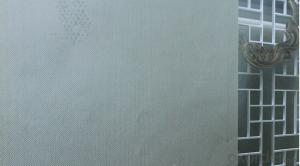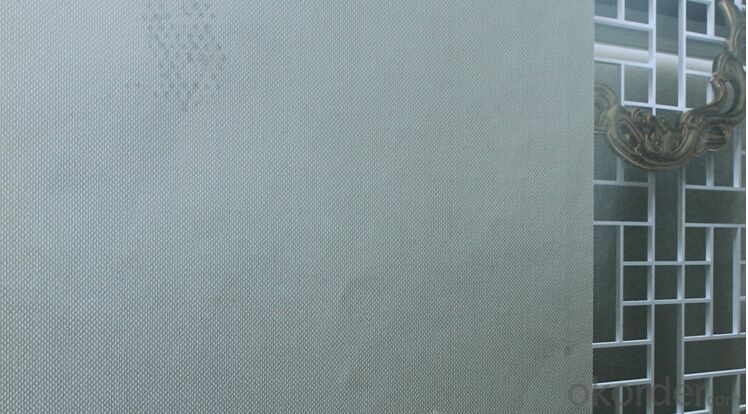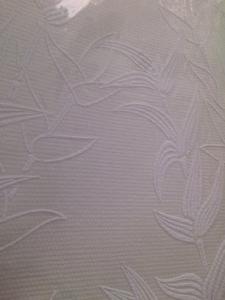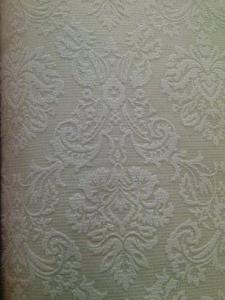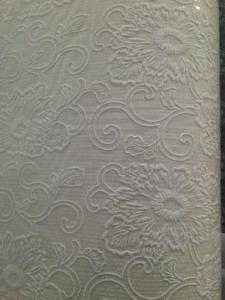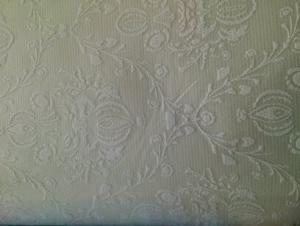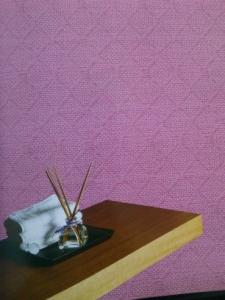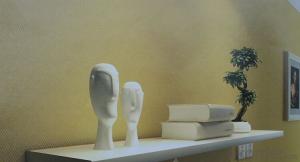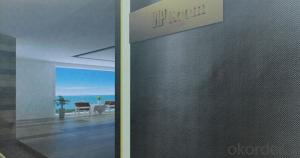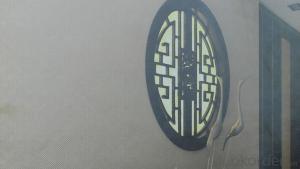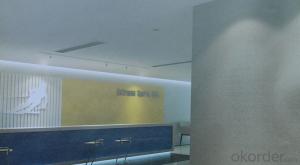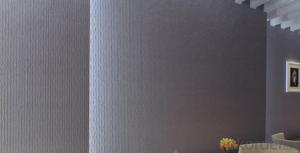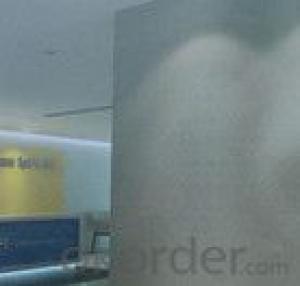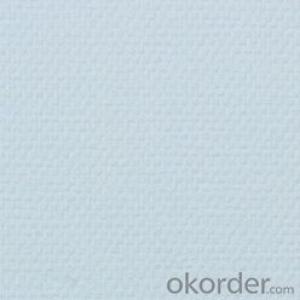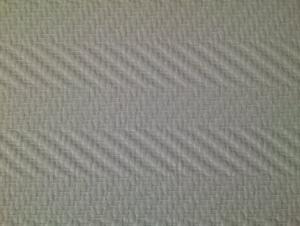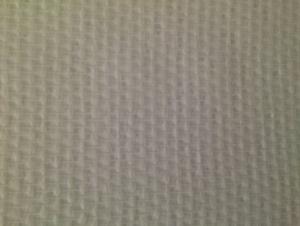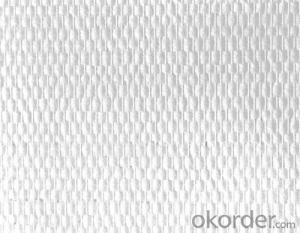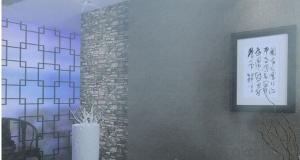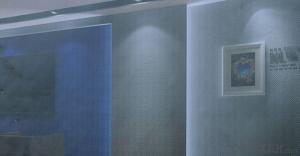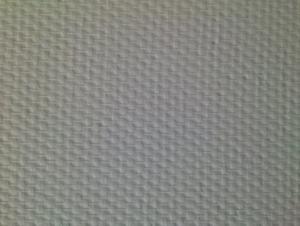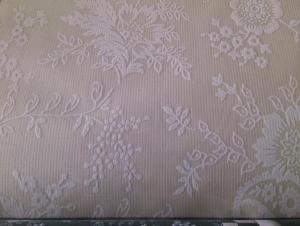Fiberglass Wallcovering Cloth 81502 - Wall Fabric
- Loading Port:
- Shanghai
- Payment Terms:
- TT OR LC
- Min Order Qty:
- 100 m²
- Supply Capability:
- 100000 m²/month
OKorder Service Pledge
OKorder Financial Service
You Might Also Like
Fiberglass Wallcovering Cloth Wall Fabric 81502
Specification of Wallcovering Cloth
.Environment-friendly
.Flame retardent
.Air permeability
.Waterproof
.Anti-corrosion
.Imcomparable strength
.Abundant patterns and colors
.Long life time
Packing Details
.Width:1m
.Length:25/50m
.Each roll of wallcovering cloth is wrapped in a shrinking polythene film,then put in carton
Introduction of wallcovering Cloth
Fiberglass wallcovering cloth,that combines the versatility of paint,from latex to epoxy,with the
strength and benefits of woven fiberglass textile yarns to meet the most demanding wall finish
requirments.Fiberglass textile yarns,as a kind of natural materials,are woven into various textures
and patterns and then treated with a natural starch binder for dimensional stability during the hanging
process.
Compared with traditional wall papers,fiberglass wall covering cloth has the following advantages:
Environment friendly,Flame Retardant,Air Permeability,Shock Resistance,Waterproofing,Anti-corrosion,Abundant Colors&Patterns.
Product Show
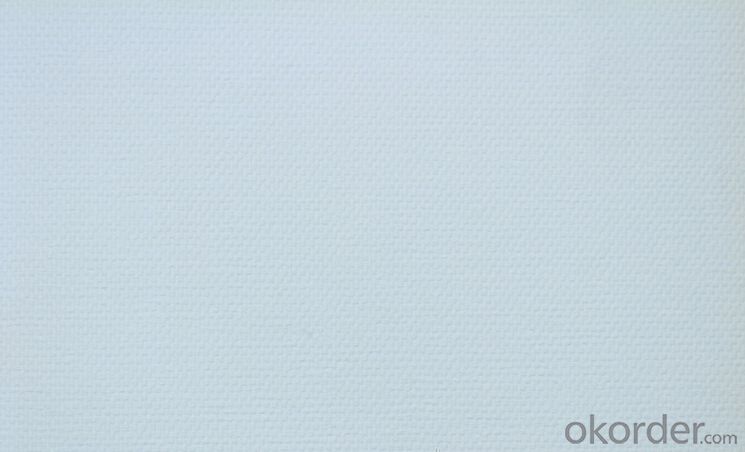
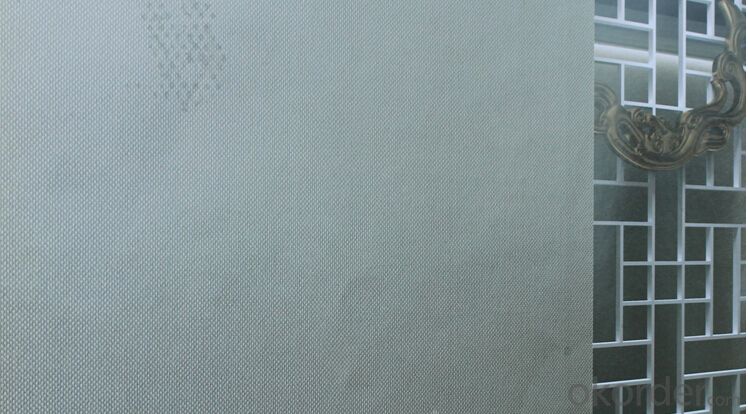
Application of Wallcovering Cloth
As a high-tech indoor decorating material,fiberglass wallcovering cloth is widely used in resident homes,
offices and shops and even cinemas,theatres,hotels and hospital faclilties,air ports,office buildings,shopping centers and schools.
Test Report
Our product has passed test by SGS as follows:
EN 12956:for determination of dimensions,straightness,spongeability and washability.
EN 12149:for determination of magration of heavy metals and certain other elements,of
vinyl monomer and of formaldehyde release.
EN 20105-B02:light solidity.
Our products had passed test of Fire Retardancy M1 Class by LINE
- Q: Can fiberglass wallcovering cloth be used in residential settings?
- Yes, fiberglass wallcovering cloth can be used in residential settings. Fiberglass wallcovering cloth is a versatile and durable material that offers numerous benefits for residential applications. It is commonly used to reinforce walls, provide insulation, and improve the overall aesthetics of a room. One of the main advantages of using fiberglass wallcovering cloth in residential settings is its durability. It is resistant to wear and tear, making it ideal for high-traffic areas such as hallways, living rooms, and children's rooms. It can withstand frequent cleaning and is less likely to get damaged compared to other wallcovering materials. Additionally, fiberglass wallcovering cloth is also fire-resistant, which is an important consideration for residential safety. It can help to slow down the spread of fire in case of an emergency, providing added protection to homeowners. Another benefit of using fiberglass wallcovering cloth is its ability to provide insulation. It can help to regulate the temperature in a room by preventing heat loss or gain, resulting in improved energy efficiency. This can lead to cost savings on heating and cooling bills. Furthermore, fiberglass wallcovering cloth is available in a wide range of designs, textures, and patterns, allowing homeowners to choose a style that suits their preferences and complements their existing decor. It can add a touch of elegance and sophistication to any residential space. However, it is important to note that fiberglass wallcovering cloth should be installed correctly to ensure optimal performance. It is recommended to hire a professional installer who has experience working with this material to ensure a proper and seamless installation. In conclusion, fiberglass wallcovering cloth can be a great choice for residential settings. Its durability, fire-resistant properties, insulation capabilities, and aesthetic options make it an excellent choice for homeowners looking to enhance the look and functionality of their living spaces.
- Q: Is fiberglass wallcovering cloth suitable for use in restaurants or food service areas?
- Yes, fiberglass wallcovering cloth is suitable for use in restaurants or food service areas. Fiberglass wallcovering cloth is a durable material that is resistant to moisture, stains, and odors, making it an ideal choice for areas where food is prepared and served. It is also easy to clean and maintain, which is important in maintaining a hygienic environment. Additionally, fiberglass wallcovering cloth is fire-resistant, which adds an extra layer of safety in restaurant settings. Overall, fiberglass wallcovering cloth is a practical and reliable option for use in restaurants or food service areas.
- Q: How easy is it to clean fiberglass wallcovering cloth?
- Cleaning fiberglass wallcovering cloth is relatively easy. The smooth surface of fiberglass makes it resistant to staining and allows for easy removal of dirt and grime. Regular cleaning can be done by simply wiping the surface with a damp cloth or using a mild detergent and water solution. For tougher stains, a soft bristle brush can be used to gently scrub the area. It is important to avoid using harsh chemicals or abrasive cleaners, as they can damage the fiberglass material. Overall, fiberglass wallcovering cloth is a low-maintenance and easy-to-clean option for interior walls.
- Q: Can fiberglass wallcovering cloth be used in retail or commercial office spaces?
- Yes, fiberglass wallcovering cloth can be used in retail or commercial office spaces. It is a durable and fire-resistant material that can withstand heavy traffic and provide a long-lasting solution for walls in these types of environments. Additionally, it offers a wide range of design options and can be easily cleaned and maintained, making it a suitable choice for retail and commercial office spaces.
- Q: What are the different types of fiberglass wallcovering cloth?
- There are several different types of fiberglass wallcovering cloth available in the market. These types can vary based on their composition, texture, and intended use. One common type of fiberglass wallcovering cloth is the woven fiberglass cloth. It is made by weaving thin fiberglass strands together, creating a sturdy and durable material. Woven fiberglass cloth is often used as a base layer for wallcoverings, providing strength and stability to the finished product. Another type is the non-woven fiberglass cloth. This type is made by bonding or needle-punching fiberglass fibers together, creating a textured and flexible material. Non-woven fiberglass cloth is commonly used in wallcoverings that require a softer and more textured appearance. Fiberglass wallcovering cloth can also be classified based on the texture of the surface. Some options include smooth, textured, embossed, or patterned fiberglass cloth. These variations allow for different aesthetic choices and can add depth and visual interest to a wallcovering. In addition to these variations, fiberglass wallcovering cloth can also be categorized based on its fire resistance. Some types of fiberglass cloth are specifically designed to have fire-resistant properties, making them suitable for use in areas where fire safety is a concern. Overall, the different types of fiberglass wallcovering cloth offer a range of options for various applications. Whether it's for durability, texture, aesthetics, or fire resistance, there is a type of fiberglass wallcovering cloth available to meet specific needs and preferences.
- Q: Can fiberglass wallcovering cloth be painted over?
- Yes, fiberglass wallcovering cloth can be painted over. However, there are a few important steps to follow in order to achieve the best results. First, ensure that the wallcovering cloth is clean and free from any dirt or dust. Next, apply a primer specifically designed for use on fiberglass surfaces. This will help the paint adhere properly and provide a smooth finish. Once the primer has dried, you can apply your desired paint color using a roller or brush. It is recommended to use a high-quality latex or acrylic paint for best results. Keep in mind that multiple coats may be necessary to achieve full coverage and a desired finish. Overall, with proper preparation and the right materials, it is possible to paint over fiberglass wallcovering cloth to achieve the desired look.
- Q: Can fiberglass wallcovering cloth be used in healthcare facilities?
- Yes, fiberglass wallcovering cloth can be used in healthcare facilities. It is a durable and easy-to-clean material that can withstand frequent cleaning and disinfection. Additionally, fiberglass wallcovering cloth is resistant to mold and mildew, making it a suitable choice for environments that require high levels of hygiene, such as healthcare facilities.
- Q: Does fiberglass wallcovering cloth provide any impact resistance?
- Yes, fiberglass wallcovering cloth does provide impact resistance. The fiberglass material used in the cloth is known for its strength and durability, making it an excellent choice for areas that require protection against impacts. When installed properly, fiberglass wallcovering cloth can provide a sturdy and resilient surface that is resistant to dents, scratches, and other forms of impact damage. This makes it particularly suitable for high-traffic areas such as hallways, commercial spaces, and public buildings where there is a higher chance of accidental impacts occurring. Additionally, fiberglass wallcovering cloth can also offer added protection against moisture and fire, further enhancing its impact resistance capabilities.
- Q: Can fiberglass wallcovering cloth be used in conjunction with decorative shelving or displays?
- Yes, fiberglass wallcovering cloth can be used in conjunction with decorative shelving or displays. Fiberglass wallcovering cloth is a versatile and durable material that can be applied to walls and other surfaces to provide a smooth and even finish. It can also be painted or textured to match any desired aesthetic. When used with decorative shelving or displays, the fiberglass cloth can provide a seamless backdrop that enhances the overall aesthetic appeal. Additionally, the strength and durability of fiberglass make it a suitable material for supporting the weight of shelving or displays, ensuring that they are securely mounted to the wall.
- Q: Is fiberglass wallcovering cloth resistant to stains and discoloration?
- Fiberglass wallcovering cloth possesses resistance against stains and discoloration. It is purposely designed to be enduring and long-lasting, resulting in high resistance against stains and discoloration caused by spills, dirt, and other typical contaminants. The non-porous fiberglass material prevents the absorption of liquids or stains, facilitating effortless cleaning and upkeep. Additionally, fiberglass wallcovering cloth is frequently treated with specialized coatings or finishes that provide an additional layer of defense against stains and discoloration. In summary, fiberglass wallcovering cloth presents outstanding resistance to stains and discoloration, making it a favored option for areas with heavy foot traffic where durability and easy maintenance are paramount.
Send your message to us
Fiberglass Wallcovering Cloth 81502 - Wall Fabric
- Loading Port:
- Shanghai
- Payment Terms:
- TT OR LC
- Min Order Qty:
- 100 m²
- Supply Capability:
- 100000 m²/month
OKorder Service Pledge
OKorder Financial Service
Similar products
Hot products
Hot Searches
Related keywords
